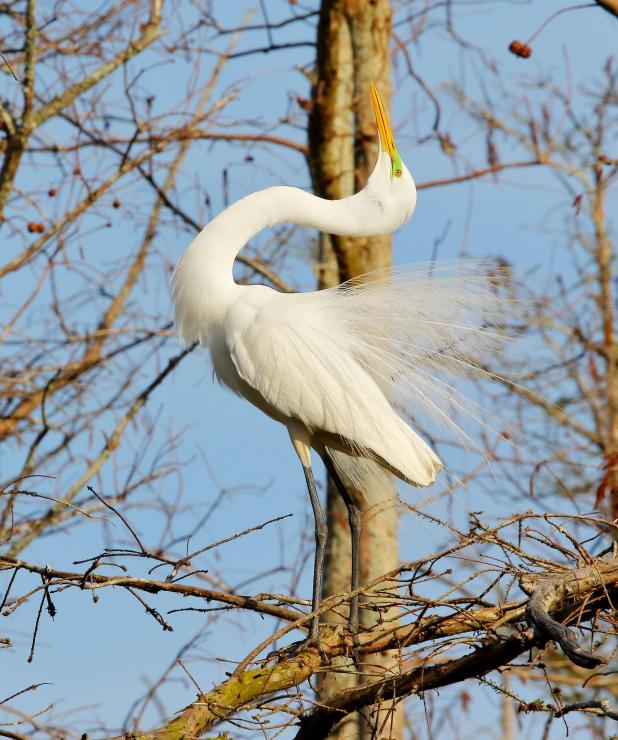
A great egret displays for its mate in a cypress tree on Cazan Lake
(Submitted Photo/John K. Flores)
Cazan Lake offers opportunities for nature lovers -- birders
Louisiana is considered to be one of the Top 5 birding states in the United States. March is considered one of those transitional months when nature lovers can enjoy seeing several hundred species of migratory birds both coming and going. This column is the first in a two-part series on Louisiana birding — the spring migrations.
Cazan Lake, (pronounced kah-zau) in a Cajun French-like accent, is a little piece of natural beauty in Evangeline Parish. The lake and surrounding wooded area is a small part of a near 4000 acre farm owned by the late Percy Fontenot, now managed by family members. In short, for birders and nature photographers, it’s an isolated Mecca where they can be lost in the wonders and beauty of the avian inhabitants of the lake’s cypress trees.
Each year in early January, Great Egrets begin to do their mating dance in the branches of the trees. The lore around the eyes of the large white birds becomes a striking lime or rich olive green.
Beautiful plumes grow on their back during breeding season and the Great Egrets raise them much like a peacock during their courtship displays. The birds arch and move their long neck much like a ballerina in the famous Swan Lake Ballet, drawing the interest of their mates.
As the month progresses, moving into February, March and late spring, hundreds of the elegant wading birds build crude nests made from twigs and small branches to lay their eggs. Spanning the first half of the year by summer solstice they have fledged their young.
Cazan Lake’s Recreational Manager, Kristi Enicke, says Fontenot envisioned a time when people would come to his farm to see the rookery that is considered one of the largest natural rookeries in the state.
Enicke said, “Early on they charged a dollar for photographers to come take pictures. Mr. Percy always said, ‘One day those birds are going to make some money, because some photographers are really going to want to come and see that.’”
Fontenot, who passed away in 2011, couldn’t have been more accurate in his prophesy. This past Saturday during a trip to Cazan Lake with my wife Christine, there were no less than seven nature photographers taking pictures of the egrets, mere moments after sunrise.
Martha Jo Ward drove close to 100 miles before daylight to get to Cazan Lake.
“I got up at 4:30 this morning and drove from Lake Charles to get here – that’s wanting to see some birds now,” Ward said laughing. “I can’t make it to church on time, but I can make here to take a picture of a bird.”
Another photographer, Mike McCarthy, drove 177 miles, one way from Shreveport. New Iberia resident, Frank Garacci, drove 80 miles one way to Cazan Lake.
Garacci, who is the area Sale Manager for Palfinger Marine, said, “I heard about Cazan Lake from a couple of photographers – Gary Meyers and James Stewart. I’ve been shooting for three years, so this is my third nesting season there. There’s not only Great Egrets, but the other little birds that come and go too.”
Saturday, besides shooting photographs of Great Egrets Garacci also took pictures of Roseate Spoonbills, White Pelicans, Ruby-crowned Kinglets, and Orange-crowned Warblers. Quite a treasure trove for a novice birder with a camera.
While at Cazan my wife and I saw Great Blue Herons nesting, Anhingas, Cormorants, Wood Ducks, Northern Shovelers, Red-Headed Woodpeckers, Red-bellied Woodpeckers, Carolina Chickadees, Carolina Wrens, White-throated Sparrows, Common Yellow-throats, among others.
Eunice resident, Tim Comeaux, didn’t have as long of a drive to get to Cazan Lake as the rest of us who were there enjoying rookery. Comeaux, who drove roughly 30 minutes, got his start in photography by actually taking pictures while piloting drones. It was something he enjoyed and after being told he had a great eye, Comeaux bought a camera for the ground.
Comeaux, who is a middle school teacher, says he discovered Cazan Lake by accident. One day, he and his wife decided to go to Chicot State Park to take a few pictures when they basically took the wrong road ending up at Cazan.
“It was in the spring of 2019 and the young egrets were just old enough to leave the nest. I was overwhelmed at watching these amazing birds operate on the limbs of the trees. So, this is my first season to watch the process from nest building to mating to chicks hatching,” Comeaux said.
Many land companies and numerous farms and ranches across the country are incorporating eco-friendly activities to increase revenues. Besides birding and nature photography, Cazan Lake also offers camp leases, duck blinds, hunting leases, fishing, and, kayaking. Additionally, a lodge is available for suppers and nightly rentals.
A day session to take pictures at the rookery costs $20 per person. There is also an annual fee option of $125 for photographers that allows them to return as often as they want to take pictures. Rates vary for other activities. For more information contact Kristi Enicke at (337) 363-1830 or by email at kristi@percyinc.com
EDITOR’S NOTE: Flores is The Daily Review’s Outdoor Writer.
